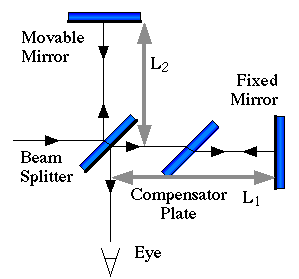

Interferometers use the principle of split light beams to study various physical phenomena related to light. One of most famous interferometers was devised by Michelson to study the motion of the earth with respect to the "ether" that was postulated to be the medium which support electromagnetic waves.
In an interferometer an incoherent light source is separated by a "beam splitter" (a half-silvered mirror) into two coherent beams. The two beams are sent on paths of different lengths and then recombined. As the movable mirror changes position, fringe appear and disappear to the eye as the two path lengths differ by multiples of a 1/2 wavelength.
In the famous Michelson experiment which formed the basis of relativity, one beam was directed parallel to the motion of the earth around the sun and the other perpendicular. Any change in light speed parallel to the motion of the earth would be visible as shifts in the observed fringe pattern. Within the errors of the experiment, no effect was observed. One possible conclusion of the experiment was that the speed of light is the same whether or not the observer and/or source is moving.
Because a motion of the moving mirror of much less than one wavelength is easily observed in an interferometer, it can be used for extremely precise length measurements. Introducing a gas into one of the paths is a very sensitive way to measure the index of refraction of the gas.
© MultiMedia Physics 2000